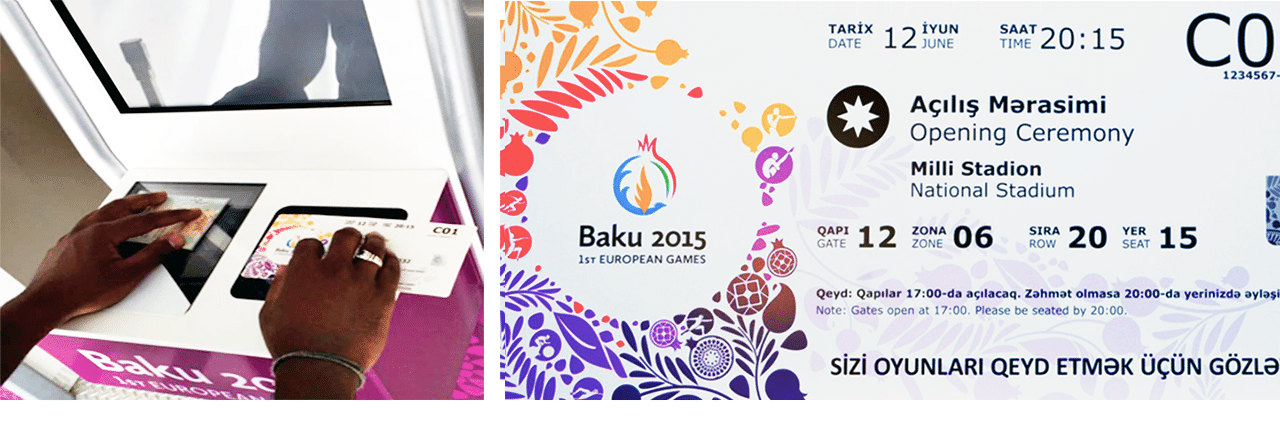Acceliot Legacy Case Study Series
Co-founders Shawn Manesh and Paul Barriga look back at groundbreaking RFID milestones from the years before Acceliot became an independent company.

Baku 2015 served as the inaugural edition of the European Games, an international multi-sport event in the Olympic tradition contested by athletes from across Europe. They were held June 12-28, 2015 in Baku, Azerbaijan.
Also known as the 1st European Games at the time, subsequent quadrennial editions have been held in Minsk, Belarus (2019) and Kraków, Poland (2023).
Baku was awarded the games by the European Olympic Committees (EOC) in December 2012. The event saw nearly 6,000 athletes from 50 countries compete in 20 sports, including Olympic sports like athletics, boxing, and gymnastics, as well as sports popular in the region but not featured in the Olympics, such as karate and sambo. Some of the events also served as qualification opportunities for the 2016 Summer Olympics in Rio de Janeiro, Brazil.
Security in the Spotlight
International sports festivals play a crucial role in bringing together national teams from around the globe, fostering a spirit of camaraderie and, at times, contributing to the easing of international tensions, however temporarily. Nonetheless, such large-scale events necessitate heightened security measures to ensure the safety of athletes, team officials, fans, media personnel, and residents of the host city, with the demand for on-site security being particularly acute. The preparations for safeguarding the Baku 2015 games began almost immediately after the announcement, underscoring the considerable pressure on the organizing committees to deliver a successful and secure event, especially given the anticipation surrounding the inaugural European Games.
The Challenge
The organizers of the games faced many challenges to ensure the comfort, safety and security of attendees and athletes. With over 250,000 people from as many as 100 countries attending, security personnel needed a discreet, unobtrusive system that gave them real-time, actionable information while ensuring attendee privacy.
Working with partner Main Development, the Mojix team supplied key elements of the RFID-enabled security system that enabled event managers located in a central control area to monitor attendance, locate individual attendees to a specific zone and view video feeds from that zone.
The STAR reader architecture was deployed with a network of over 1000 antennas in high-traffic zones. Equipped with a user-configurable rules engine and big-data time-series analysis capability, the system provided actionable information for security personnel at the three main venues, the Olympic Stadium, the National Gymnastics Arena and the Crystal Hall Arena.

The Solution
Visitors to the games used self-service, RFID-enabled kiosks developed by Main Development to register and print their tickets. The kiosk took a photo and scanned each visitor’s passport, extracting identification information via optical character recognition. At the same time, the user’s RFID-enabled ticket was programmed with a serial number. The identification information and serial number were then stored in the system database. Visitors used the tickets to enter venues, patronize concessions and when taking their seats. Identified by number (not name) in the system, users’ privacy was protected by ensuring strict access controls to the database.


The Result
The Mojix software platform and STAR RFID architecture enhanced event security by offering unparalleled attendee visibility and traceability directly from a centralized security hub, thus safeguarding both the attendees and athletes. This sophisticated solution furnished immediate, actionable insights, enabling security teams to swiftly address any incidents. This technology approach effortlessly integrated with pre-existing on-site security frameworks, enhancing their capabilities.
Key features of the Main Development solution included:
- Capturing attendee data upon registration at self-service kiosks, ensuring a streamlined entry process.
- Monitoring attendance figures across different areas and zones, providing insights into crowd dynamics.
- Implementing customizable rules to trigger alerts for specific scenarios, such as unauthorized entry, enhancing area security.
- Merging attendee locations from the STAR RFID system with live video feeds, offering a comprehensive view of the event space in real-time.
- Facilitating quick access to detailed attendee profiles and their movement history, aiding in efficient incident resolution.
- Offering flexible reconfiguration of security parameters, including rules, zones, and alerts, to adapt to evolving security needs swiftly.

This comprehensive security solution ensured a safer environment for all event participants, allowing for real-time response and management of security concerns.
Acceliot DNA
Baku 2015 highlighted the flexibility of the STAR platform and its wide-area RFID performance. It also reflected the hybrid architecture that powers Acceliot’s STARflex solutions today. In addition to STAR readers and antennas, the European Games solution also collected data from traditional third-party RFID readers that did not require RTLS functionality, showcasing the platform’s ability to incorporate non-STAR elements in a holistic approach.
